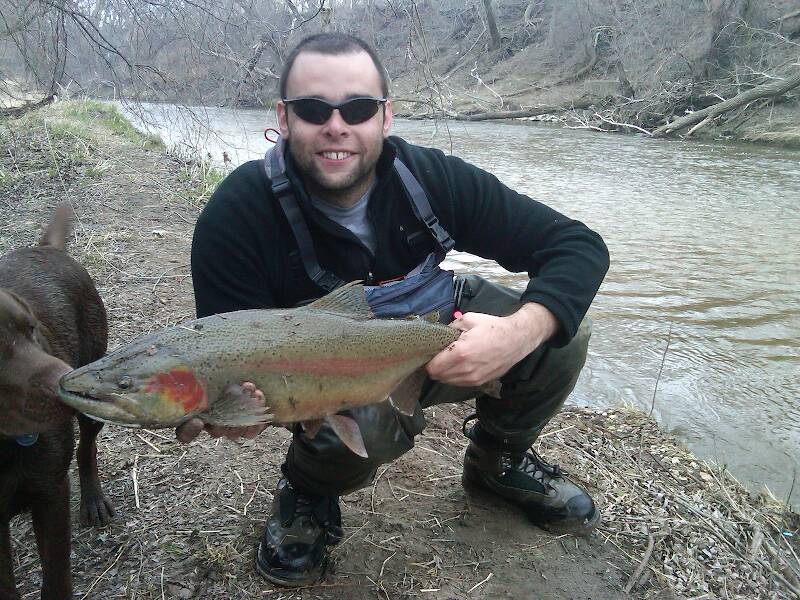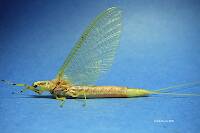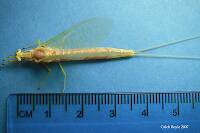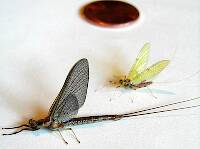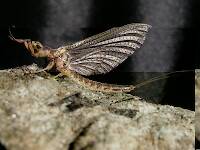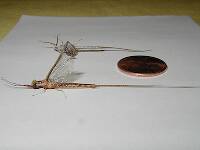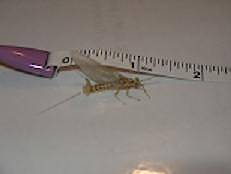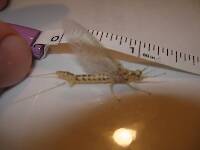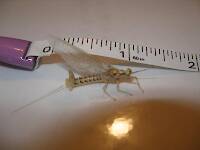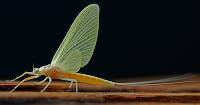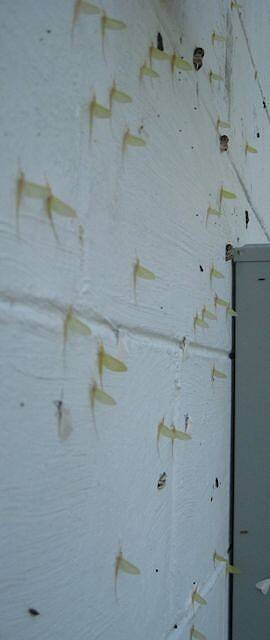
Hex Mayflies
Hexagenia limbata
The famous nocturnal Hex hatch of the Midwest (and a few other lucky locations) stirs to the surface mythically large brown trout that only touch streamers for the rest of the year.
Featured on the forum

This specimen keys pretty easily to Onocosmoecus, and it closely resembles a specimen from Alaska which caddis expert Dave Ruiter recognized as this genus. As with that specimen, the only species in the genus documented in this area is Onocosmoecus unicolor, but Dave suggested for that specimen that there might be multiple not-yet-distinguished species under the unicolor umbrella and it would be best to stick with the genus-level ID. I'm doing the same for this one.

Troutnut is a project started in 2003 by salmonid ecologist Jason "Troutnut" Neuswanger to help anglers and
fly tyers unabashedly embrace the entomological side of the sport. Learn more about Troutnut or
support the project for an enhanced experience here.
CaseyP on Jul 3, 2013July 3rd, 2013, 7:06 am EDT
fished Pittsburg, NH, at Back Lake last week for the hex hatch and enjoyed it immensely. the bugs were really big, wings standing perhaps as high as 3 inches off the water, and bodies about as long.
then fished a pond in VT with the same color bugs hatching at the same time in the same manner, but they were about half the size.
different bug? different ecology, therefore smaller?
trout loved them either size.
then fished a pond in VT with the same color bugs hatching at the same time in the same manner, but they were about half the size.
different bug? different ecology, therefore smaller?
trout loved them either size.
"You can observe a lot by watching." Yogi Berra
Kschaefer3 on Jul 3, 2013July 3rd, 2013, 7:52 am EDT
trout loved them either size.
Sayfu
Posts: 560
Posts: 560
Sayfu on Jul 3, 2013July 3rd, 2013, 12:00 pm EDT
On my SF of the Snake big fish will often take the smaller bug...Big salmonflies out that are huge, and the fish will often rise to the smaller golden stones much better.
Taxon on Jul 3, 2013July 3rd, 2013, 1:38 pm EDT
Hi Casey-
The Hexagenia emerging in NH were probably H. limbata, and those emerging in VT were probably H. rigida. Different species, but so similar that distinguishing one from the other requires microscopic examination of the genitalia of a male imago.
fished Pittsburg, NH, at Back Lake last week for the hex hatch and enjoyed it immensely. the bugs were really big, wings standing perhaps as high as 3 inches off the water, and bodies about as long.
then fished a pond in VT with the same color bugs hatching at the same time in the same manner, but they were about half the size.
different bug? different ecology, therefore smaller?
trout loved them either size.
The Hexagenia emerging in NH were probably H. limbata, and those emerging in VT were probably H. rigida. Different species, but so similar that distinguishing one from the other requires microscopic examination of the genitalia of a male imago.
CaseyP on Jul 3, 2013July 3rd, 2013, 5:18 pm EDT
so similar that distinguishing one from the other requires microscopic examination of the genitalia of a male imago
umm...instead of just measuring the wings?
or does size not matter...
"You can observe a lot by watching." Yogi Berra
Taxon on Jul 3, 2013July 3rd, 2013, 6:49 pm EDT
Hi Casey-
Once upon a time, there were believed to be many more species of Hexagenia than there are today. Many of those earlier-identified "species" were combined with Hexagenia limbata. The following excerpt from Mayfly Central's Species List - North American documents this species concept re-definition:
Hexagenia limbata (Serville), 1829 [CAN:FN,NE,NW;MEX:FS,SW;USA:NE,NW,SE,SW]
Ephemera limbata Serville, 1829 (orig.)
Hexagenia affiliata McDunnough, 1927 (syn.)
Hexagenia californica Upholt, 1937 (syn.)
Hexagenia carolina Traver, 1931 (syn.)
Hexagenia elegans Traver, 1931 (syn.)
Hexagenia kanuga Traver, 1937 (syn.)
Hexagenia marilandica Traver, 1931 (syn.)
Hexagenia mingo Traver, 1931 (syn.)
Hexagenia munda Eaton, 1883 (syn.)
Hexagenia occulta (Walker), 1853 (syn.)
Hexagenia pallens Traver, 1935 (syn.)
Hexagenia rosacea Traver, 1931 (syn.)
Hexagenia variabilis Eaton, 1883 (syn.)
Hexagenia venusta Eaton, 1883 (syn.)
Hexagenia viridescens (Walker), 1853 (syn.)
Hexagenia weewa Traver, 1931 (syn.)
Palingenia limbata (Serville), 1829 (comb.)
Palingenia occulta Walker, 1853 (syn.)
Palingenia viridescens Walker, 1853 (syn.)
As a result, Hexagenia limbata subimagoes/imagoes vary in body length from ~12 mm to ~37 mm, whereas Hexagenia rigida vary in body length from ~19 to ~20 mm, and forewing lengths are approximately the same as (or slightly shorter than) body lengths.
Once upon a time, there were believed to be many more species of Hexagenia than there are today. Many of those earlier-identified "species" were combined with Hexagenia limbata. The following excerpt from Mayfly Central's Species List - North American documents this species concept re-definition:
Hexagenia limbata (Serville), 1829 [CAN:FN,NE,NW;MEX:FS,SW;USA:NE,NW,SE,SW]
Ephemera limbata Serville, 1829 (orig.)
Hexagenia affiliata McDunnough, 1927 (syn.)
Hexagenia californica Upholt, 1937 (syn.)
Hexagenia carolina Traver, 1931 (syn.)
Hexagenia elegans Traver, 1931 (syn.)
Hexagenia kanuga Traver, 1937 (syn.)
Hexagenia marilandica Traver, 1931 (syn.)
Hexagenia mingo Traver, 1931 (syn.)
Hexagenia munda Eaton, 1883 (syn.)
Hexagenia occulta (Walker), 1853 (syn.)
Hexagenia pallens Traver, 1935 (syn.)
Hexagenia rosacea Traver, 1931 (syn.)
Hexagenia variabilis Eaton, 1883 (syn.)
Hexagenia venusta Eaton, 1883 (syn.)
Hexagenia viridescens (Walker), 1853 (syn.)
Hexagenia weewa Traver, 1931 (syn.)
Palingenia limbata (Serville), 1829 (comb.)
Palingenia occulta Walker, 1853 (syn.)
Palingenia viridescens Walker, 1853 (syn.)
As a result, Hexagenia limbata subimagoes/imagoes vary in body length from ~12 mm to ~37 mm, whereas Hexagenia rigida vary in body length from ~19 to ~20 mm, and forewing lengths are approximately the same as (or slightly shorter than) body lengths.
Jmd123 on Jul 4, 2013July 4th, 2013, 9:12 am EDT
Hey look everybody, Roger finally metamorphosed into an adult!!!
;oD
Jonathon
P.S. I also recently changed from a guy holding a smallmouth to a guy sitting in a yellow kayak...
;oD
Jonathon
P.S. I also recently changed from a guy holding a smallmouth to a guy sitting in a yellow kayak...
No matter how big the one you just caught is, there's always a bigger one out there somewhere...
CaseyP on Jul 4, 2013July 4th, 2013, 1:14 pm EDT
vary in body length from ~12 mm to ~37 mm
okay, so wing/body length is not the determining factor. thanks!
the hexes on the screen at the lodge looked larger than 35mm, but of course any bug nearly that size looks enormous, especially on the glassy surface of the lake at sunset.
so, hexes rule, big and small!
the fish in the pond are never fished for, and after one gulped down two real flies and one fishing fly in less time than it takes to tell, i felt bad and stopped fishing. my excuse was the water was kind of warm...
"You can observe a lot by watching." Yogi Berra
Quick Reply
Related Discussions
Topic
Replies
Last Reply
10
Jun 30, 2009
by Jmd123
by Jmd123
5
Dec 4, 2008
by Beardius
by Beardius
20
Nov 1, 2011
by Jmd123
by Jmd123



